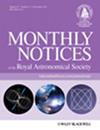Abundant sub-micron grains revealed in newly discovered extreme debris discs
IF 4.7
3区 物理与天体物理
Q1 ASTRONOMY & ASTROPHYSICS
引用次数: 0
Abstract
Extreme debris discs (EDDs) are bright and warm circumstellar dusty structures around main sequence stars. They may represent the outcome of giant collisions occuring in the terrestrial region between large planetesimals or planetary bodies, and thus provide a rare opportunity to peer into the aftermaths of these events. Here, we report on results of a mini-survey we conducted with the aim to increase the number of known EDDs, investigate the presence of solid-state features around 10 μm in eight EDDs, and classify them into the silica or silicate dominated groups. We identify four new EDDs and derive their fundamental properties. For these, and for four other previously known discs, we study the spectral energy distribution around 10 μm by means of VLT/VISIR photometryin three narrow-band filters and conclude that all eight objects likely exhibit solid-state emission features from sub-micron grains. We find that four discs probably belong to the silicate dominated subgroup. Considering the age distribution of the entire EDD sample, we find that their incidence begins to decrease only after 300 Myr, suggesting that the earlier common picture that these objects are related to the formation of rocky planets may not be exclusive, and that other processes may be involved for older objects (≳100 Myr). Because most of the older EDD systems have wide, eccentric companions, we suggest that binarity may play a role in triggering late giant collisions.在新发现的极端碎片盘中发现丰富的亚微米级颗粒
极端碎片盘(EDDs)是主序星周围明亮而温暖的星周尘埃结构。它们可能是大型行星或行星体之间在地球区域发生的巨大碰撞的结果,因此为窥探这些事件的后果提供了一个难得的机会。在这里,我们报告了我们进行的一次小型调查的结果,目的是增加已知 EDDs 的数量,调查 8 个 EDDs 中 10 μm 附近固态特征的存在情况,并将它们归入硅石或硅酸盐为主的组别。我们发现了四个新的 EDDs,并推导出它们的基本特性。我们利用 VLT/VISIR 光度计的三个窄带滤光片研究了这些圆盘和另外四个以前已知的圆盘在 10 μm 附近的光谱能量分布,并得出结论:所有八个天体都可能表现出亚微米晶粒的固态发射特征。我们发现有四个圆盘可能属于硅酸盐为主的子群。考虑到整个EDD样本的年龄分布,我们发现它们的发生率在300 Myr之后才开始下降,这表明早先认为这些天体与岩质行星的形成有关的普遍看法可能并不完全正确,更老的天体(≳100 Myr)可能还涉及其他过程。由于大多数较老的EDD系统都有宽大、偏心的伴星,我们认为二体性可能在引发晚期巨行星碰撞中起到了一定的作用。
本文章由计算机程序翻译,如有差异,请以英文原文为准。
求助全文
约1分钟内获得全文
求助全文
来源期刊

Monthly Notices of the Royal Astronomical Society
ASTRONOMY & ASTROPHYSICS-
CiteScore
9.10
自引率
37.50%
发文量
3198
审稿时长
3 months
期刊介绍:
Monthly Notices of the Royal Astronomical Society is one of the world''s leading primary research journals in astronomy and astrophysics, as well as one of the longest established. It publishes the results of original research in positional and dynamical astronomy, astrophysics, radio astronomy, cosmology, space research and the design of astronomical instruments.
 求助内容:
求助内容: 应助结果提醒方式:
应助结果提醒方式:


